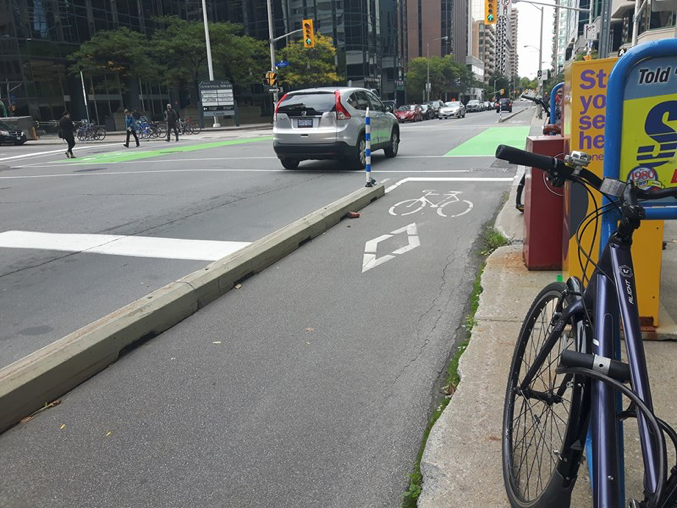City releases results of audit on Laurier bike lanes
By Meghan Newman
A year after the death of a cyclist in downtown Ottawa, the City of Ottawa has installed new safety devices on O’Connor Street and is reviewing a consultant’s recommendations on reducing hazards along the Laurier Avenue segregated bike lanes.
In early October, city council released the results of an audit of the Laurier Avenue lanes performed by the Dutch transportation consulting company Mobycon.
“Council has always put public safety for all users of the road, including cyclists, as a priority. The City wants everyone to be able to move around the city in a safe and comfortable environment,” said Vivi Chi, director of transportation planning.
The report shows that, “the overall volume and severity of conflicts has reduced substantially over the four years after the segregated bike lane was installed. This indicates that users are getting used to the facility and adjusting their behaviour,” said Phil Landry, director of traffic services.
Despite overall improvement, the Mobycon report noted continued areas of weakness. Chief among them is the heightened risk of a collision involving a right-turning vehicle, as this still accounts for 50 per cent of all collisions between cyclists or pedestrians and vehicles along the corridor. The audit also recommended simplified and clarified signage.
The audit was ordered by city council after 23-year-old Willis College student Nusrat Jahan was “right hooked” and killed in September 2016 by a truck turning across the Laurier bike lane onto Lyon Street.
Elsewhere in the downtown core, the city recently installed new cameras and LED lights at the intersection of O’Connor and Waverley streets. The system is the result of a partnership between Safer Roads Ottawa — a city task force involving police, fire and paramedic services as well as the city’s public works and public health departments — and Stittsville-based SmartCone Technologies Inc.
Rob Wilkinson, coordinator of Safer Roads Ottawa, said the city approached SmartCone because of concerns that a particular type of collision kept happening at the intersection: vehicles turning through the bike lanes onto Waverley.
“Two collisions were related to what we would call a left hook. In both cases the drivers said that they didn’t really see the cyclist,” said Wilkinson. This prompted Safer Roads to see if there was any technology that could help heighten driver awareness of cyclists at that particular location.
The technology implemented is a system of thermal cameras and LED light poles. “Thermal cameras allow us to use camera technology without invading privacy and also reduces a lot of false positives,” said Smartcone CEO Jason Lee.
The thermal cameras have a detection range of about eight metres and use algorithms to detect the direction and speed of cyclists, meaning the warning lights will only flash when they detect a cyclist entering the intersection. Once an inbound cyclist is detected, the lights flash to alert drivers that a cyclist is approaching the cross street.
The signal technology is two-fold; it alerts drivers that there is a cyclist, and it reminds cyclists that they are approaching an intersection and should be extra vigilant. “They should also know to be careful. People always say to their kids, ‘Look both ways before you cross the street.’ And that also applies to cyclists regardless if there’s a safety system or not,” said Lee.
The technology is a prototype version. Safe cycling advocates and municipal officials around the world are watching the Ottawa experiment closely, said Lee.
The technology is just one example of the efforts being made both locally and globally to make shared roads safer for drivers and cyclists alike.
“Ultimately the goal of the Safer Roads project is to reduce collisions for all road users and to reduce traffic fatalities and injuries to zero,” said Wilkinson. “We use technology as much as possible to help us on that journey.”

